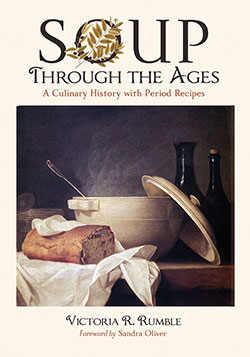Soup Through the Ages
A Culinary History with Period Recipes
$39.95
In stock
About the Book
As cooking advanced from simply placing wild grains, seeds, or meat in or near a fire to following some vague notion of food as a pleasing experience, soup—the world’s first prepared dish—became the unpretentious comfort food for all of civilization.
This book provides a comprehensive and worldwide culinary history of soup from ancient times. Appendices detail vegetables and herbs used in centuries-old soup traditions and offer dozens of recipes from the medieval era through World War II.
About the Author(s)
Bibliographic Details
Victoria R. Rumble
Format: softcover (7 x 10)
Pages: 280
Bibliographic Info: 29 photos, appendices, notes, bibliography, index
Copyright Date: 2009
pISBN: 978-0-7864-3961-4
eISBN: 978-0-7864-5390-0
Imprint: McFarland
Table of Contents
Acknowledgments vi
Foreword by Sandra Oliver 1
Preface 3
PART ONE : THE OLD WORLD
1. Soup—The World’s First Prepared Dish 7
2. Social Culture and Emerging Cuisines 10
3. Ancient Egypt 13
4. Biblical Fare 14
5. Ancient Greece 19
6. Ancient Rome 23
7. The Medieval Period 30
8. The Renaissance Era and Beyond 38
9. Open Hearth Development 41
10. Ireland 49
11. Scotland 54
12. England and Wales 63
13. France 69
14. Germany and Poland 77
15. Remaining European and Mediterranean 80
16. Asia 87
PART TWO : THE NEW WORLD
17. American Indian 91
18. Colonial America 108
19. Bartram and Kalm 119
20. Portable Soup 123
21. Army and Military Soup 125
22. Overland Trail 141
23. Slave Food to Soul Food 145
24. Tavern Food 151
25. Modern Jewish Soups 154
26. Nineteenth Century America 156
27. Cajun and Creole 173
28. Economic Depressions 177
29. Soup Kitchens 180
30. Life on the Home Front 184
31. Outdoor Soup 187
32. Soup as a Weapon 191
Appendix I: Period Soup Vegetables and Herbs 193
Appendix II: Period Recipes 199
Appendix III: Some Early Cookery Books 231
Appendix IV: Sources for Cookery Items 233
Chapter Notes 235
Bibliography 247
Index 265
Book Reviews & Awards
“a culinary smorgasbord of historical soups”—C&RL News; “Massive amount of research…a solid contribution to culinary history!”—Andrew F. Smith, editor in chief, The Oxford Companion to American Food and Drink; “Rumble…proves she is a consummate researcher and an entertaining writer. Her works possess a quality so lacking in may historical tomes of today; the ability to impart knowledge while making it an enjoyable read in the process! For those of you who thought soup was nothing but a can of Campbell’s and a little water or a couple of bouillon cubes, get your taste buds ready for a delight. This book proves that history and good tasting food are not mutually exclusive!”—Steve Abolt, President 7th US Infantry Living History Association Military Historian and Historian Film Consultant; “Victoria Rumble has written a book that is rich with flavor and with history. The worldwide references, the foodways, and the recipes create a book that will inform every bowl of soup that you prepare—or eat! It is a book that belongs on the bookshelves of all historians. The development of soup is the development of civilization.”—Elizabeth M. Williams, President Southern Food and Beverage Museum.





